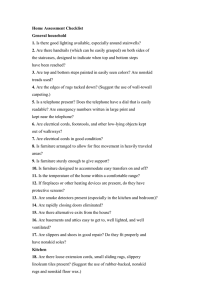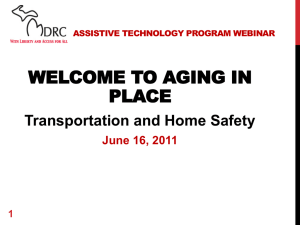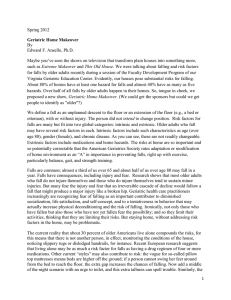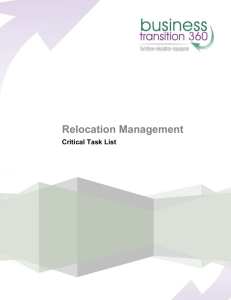Prevent Falls CE 2014 - Argus Home Health Care
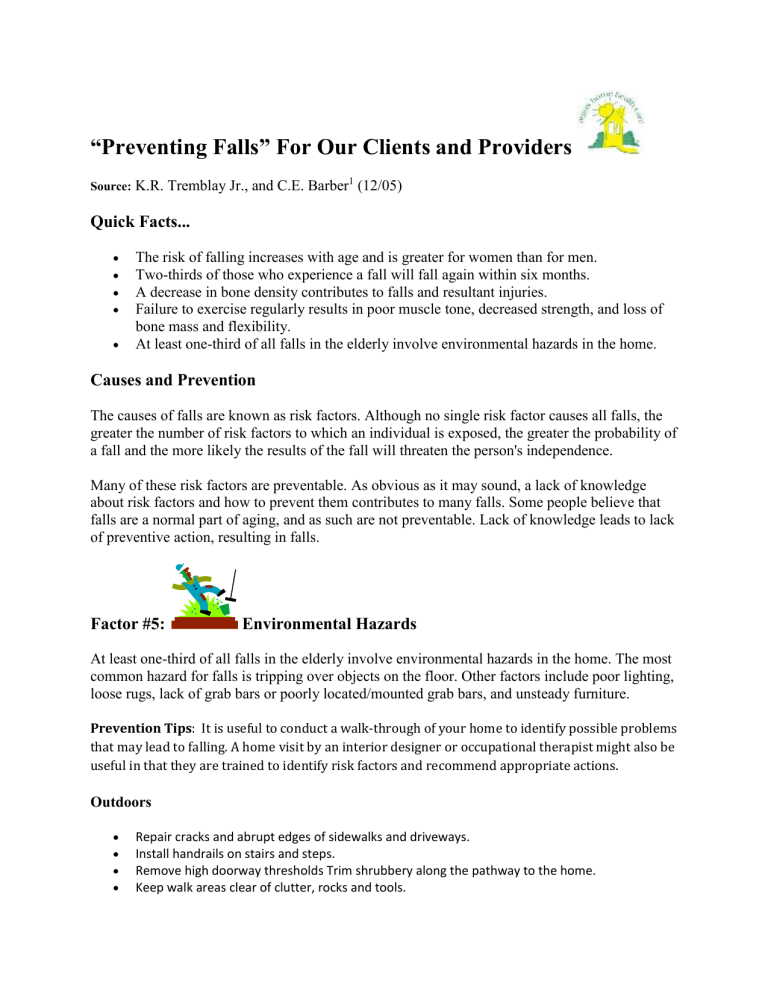
“Preventing Falls” For Our Clients and Providers
Source: K.R. Tremblay Jr., and C.E. Barber
1
(12/05)
Quick Facts...
The risk of falling increases with age and is greater for women than for men.
Two-thirds of those who experience a fall will fall again within six months.
A decrease in bone density contributes to falls and resultant injuries.
Failure to exercise regularly results in poor muscle tone, decreased strength, and loss of
bone mass and flexibility.
At least one-third of all falls in the elderly involve environmental hazards in the home.
Causes and Prevention
The causes of falls are known as risk factors. Although no single risk factor causes all falls, the greater the number of risk factors to which an individual is exposed, the greater the probability of a fall and the more likely the results of the fall will threaten the person's independence.
Many of these risk factors are preventable. As obvious as it may sound, a lack of knowledge about risk factors and how to prevent them contributes to many falls. Some people believe that falls are a normal part of aging, and as such are not preventable. Lack of knowledge leads to lack of preventive action, resulting in falls.
Factor #5: Environmental Hazards
At least one-third of all falls in the elderly involve environmental hazards in the home. The most common hazard for falls is tripping over objects on the floor. Other factors include poor lighting, loose rugs, lack of grab bars or poorly located/mounted grab bars, and unsteady furniture.
Prevention Tips: It is useful to conduct a walk-through of your home to identify possible problems that may lead to falling. A home visit by an interior designer or occupational therapist might also be useful in that they are trained to identify risk factors and recommend appropriate actions.
Outdoors
Repair cracks and abrupt edges of sidewalks and driveways.
Install handrails on stairs and steps.
Remove high doorway thresholds Trim shrubbery along the pathway to the home.
Keep walk areas clear of clutter, rocks and tools.
Keep walk areas clear of snow and ice.
Install adequate lighting by doorways and along walkways leading to doors.
All Living Spaces
Use a change in color to denote changes in surface types or levels.
Secure rugs with nonskid tape as well as carpet edges.
Avoid throw rugs.
Remove oversized furniture and objects.
Have at least one phone extension in each level of the home and post emergency numbers at each phone.
Add electrical outlets.
Reduce clutter.
Check lighting for adequate illumination and glare control.
Maintain nightlights or motion-sensitive lighting throughout home.
Use contrast in paint, furniture and carpet colors.
Install electronic emergency response system if needed.
Bathrooms
Install grab bars on walls around the tub and beside the toilet, strong enough to hold your weight.
Add nonskid mats or appliqués to bathtubs.
Mount liquid soap dispenser on the bathtub-wall.
Install a portable, hand-held shower head.
Add a padded bath or shower seat.
Install a raised toilet seat if needed.
Use nonskid mats or carpet on floor surfaces that may get wet.
Kitchen
Keep commonly used items within easy reach.
Use a sturdy step stool when you need something from a high shelf.
Make sure appliance cords are out of the way.
Avoid using floor polish or wax in order to reduce slick surfaces.
Living, Dining and Family Rooms
Keep electrical and telephone cords out of the way.
Arrange furniture so that you can easily move around it (especially low coffee tables).
Make sure chairs and couches are easy to get in and out of.
Remove caster wheels from furniture.
Use television remote control and cordless phone.
Bedroom
Put in a bedside light with a switch that is easy to turn on and off (or a touch lamp).
Have a nightlight.
Locate telephone within reach of bed.
Adjust height of bed to make it easy to get in and out of.
Have a firm chair, with arms, to sit and dress.
Stairways, Hallways and Pathways
Keep free of clutter
Make sure carpet is secured and get rid of throw rugs.
Install tightly fastened hand rails running the entire length and along both sides of stairs.
Handrails should be 34 inches high and have a diameter of about 1.5 inches.
Apply brightly colored tape to the face of the steps to make them more visible.
Optimal stair dimensions are 7.2 inch riser heights with either an 11 or 12 inch tread width.
Have adequate lighting in stairways, hallways and pathways, with light switches placed at each end.
****
All these safety hazards need to be considered in relationship to providers as well. Please report any unsafe situation or concern to your supervisor or the Human Resources Department.
Home Safety to Prevent Falls Quiz
Name_________________ Date_________
Please answer the following as a review of the Environmental Risk Factors.
Circle the appropriate answer T=True F-False
1.
T F Two-thirds of those that have fallen once will fall again within a year
2.
T F Causes of falls are known as risk factors
3.
T F People only fall in their homes so you need not worry about the outside areas
4.
T F There should only be one color throughout a person’s home because too many colors will just confuse them.
5.
T F Falling is a normal part of aging and can only happen because you are getting older.
6.
T F The height of a bed is an important factor to consider for safely getting in and out.
7.
T F Impaired vision can impact depth perception and therefore increase the risk of falling
8.
T F Assisting an individual to clear hallways and walkways will significantly decrease the risk for falling
9.
T F The risk of falling is greater for men because they always move faster
10.
T F An individual should have wheels on their furniture in order to make them easier to move out of the way so they won’t fall
11.
T F An Electronic Emergency Response System is something Argus Home
Health could provide


